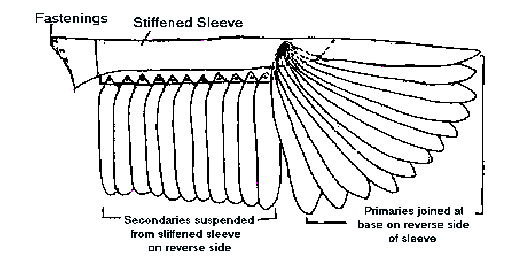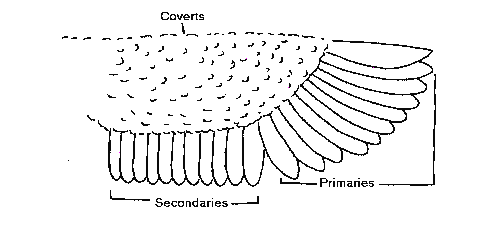This page used to be on the old Vulpes.Net site, and was originally taken from a website that is no longer around. I forget who it was from originally.
By far the most challenging aspect of this costume was the wings. I wanted to be able to move well in this costume, and in particular to move like a bird; that, of course, included the wings. The first stage was to study the anatomy of a bird and in particular the wing structure.


The most important thing I had to consider was that the wingspan of a bird (ie. measurement from wing tip to wing tip) is at least double the length of the bird from beak to end of tail. This meant that the costume was going to have a wingspan somewhere in the region of three metres. My measure-ment from finger tip to finger tip is approx-imately 1.5 metres; in other words I was going to need the wings to extend beyond each hand by nearly three quarters of a metre, and I wanted to be able to move them in a bird like fashion. A close look at the structure of a bird’s wing is shown on the left. This had to be translated into a practical design for the costume and the only way to work it out was to make a much reduced version out of thin card that I could scale up when I felt I had got it correct. This was the result:-

Basically, I decided that the first primary feather would double up as an inner sleeve which could be attached to the jacket by means of hooks and eyes at the shoulder. All the primary feathers would extend from my hand, their bases being pinned together by means of a nut and a very long bolt passing through an eyeletted hole in each feather. All the primaries had a length of galvanized steel wire running through them which roughly corresponded to the quill. The feathers were linked together about half way down with fine fishing line, and by raising and lowering my hand at the wrist I could open or close the feathers in a fanlike manner. The secondary feathers hung from the inner sleeve. Each feather was attached to the strip of shirt stiffening in the sleeve by means of a holt passing through eyeletted holes in both feather and sleeve. The secondaries were also linked together with fishing line. Once hooked into position, the wings were covered by the jacket sleeve, which doubled up as the coverts; these were held in place by means of a heavy duty snap at the end of the sleeve. As with the tail feathers, all the flight feathers had a layer of shirt stiffening inside the fabric.

For another way to do this, see the Realistic Wing Tutorial on DeviantArt.